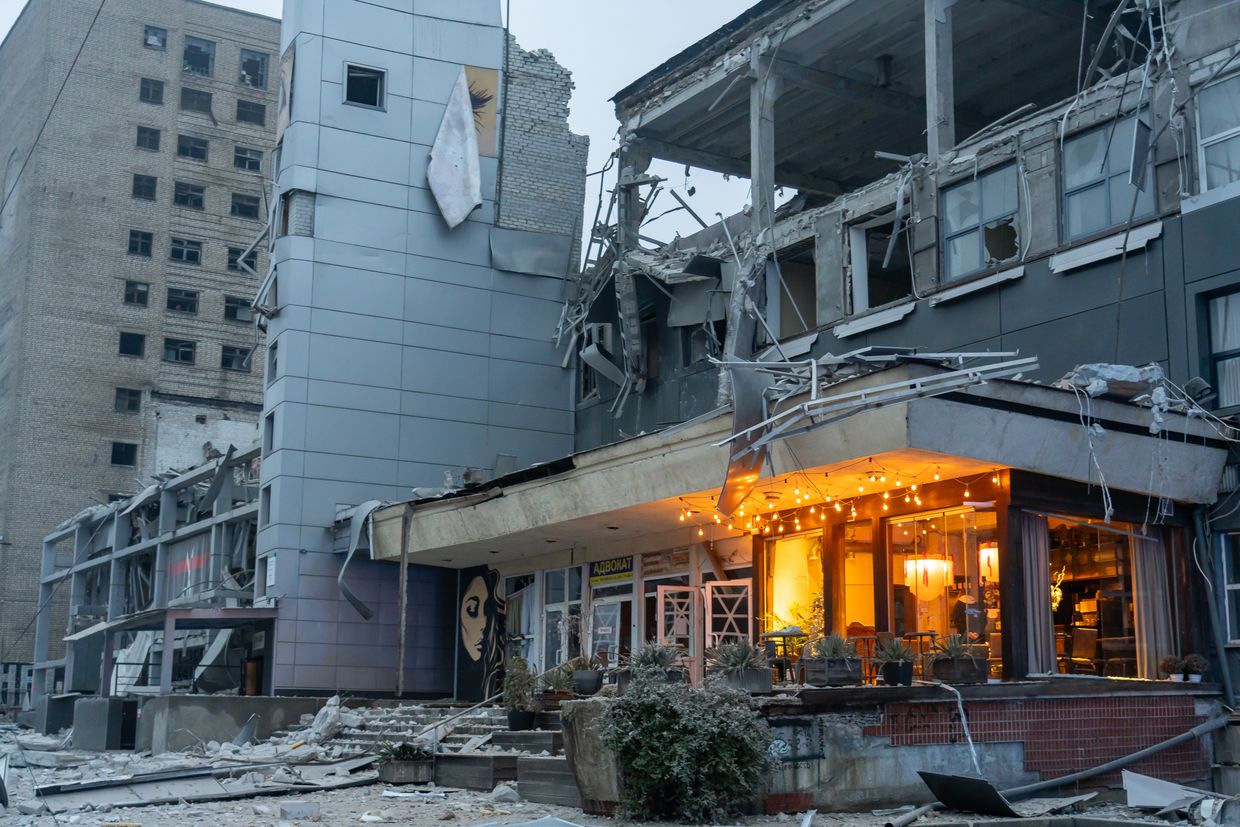
As leaders attend Ukraine Recovery Conference, rebuilding is distant dream for Ukrainians who need it most
An apartment complex in the town of Borodianka, Kyiv Oblast lies in ruins following a Russian attack, on April 8, 2022. (Footage by Servet Ulku /Anadolu Agency via Getty Images)
From her window, Elena Demchenko can see the school where she taught for 17 years. Nearly three years have passed since Izium was liberated from Russian occupation, yet the building still lies in ruins.
"People still live with damaged roofs, windows, and doors — there are so many old ladies that live alone in their apartments, earn a $50 monthly pension, and have no idea what to do," according to Demchenko, who lived through Russian occupation.
When Ukrainian forces retook Izium in September 2022, they found Kharkiv Oblast's third-largest city in ruins, with 80% of it destroyed. As in many other liberated areas, residential buildings suffered the heaviest damage.
"The destruction was enormous, unbelievable — there were no windows, no roofs, nothing," says Demchenko.
But 530 kilometers to the west, the modern and manicured Kyiv suburb of Bucha boasts sleek housing, smooth pavements, and a 1-million square foot shopping mall under construction.
Both small towns of about 40,000 before the full-scale invasion, Izium and Bucha endured destruction, Russian occupation, civilian massacres, and subsequent liberation. Today, only one of them feels like its former self.
While reconstruction is transforming some communities, much of the most brutal damage in eastern Ukraine remains unaddressed. The Ukraine Recovery Conference in Rome on July 10-11 is meant to chart a path forward — but with Russia advancing on the battlefield and no peace in sight, those still trying to help wonder if these communities will ever be restored to life.

Russia’s invasion of Ukraine has caused immense physical damage — $176 billion worth as of December 2024, according to the World Bank.
Eastern Ukraine has borne the brunt of constant artillery, drone, and missile attacks. A crescent of the worst damage tracks the front line through Kharkiv, Luhansk, Donetsk, Zaporizhzhia, and Kherson oblasts, which have sustained two-thirds of the total damage.
"Along the front line, a huge amount of damage is just broken windows," according to Harry Blakiston Houston, founder of Insulate Ukraine, a Lviv-based NGO that has installed almost 50,000 shatterproof windows in front-line regions since January 2023.
"A shell will hit a building and tend to shatter windows on any building within 50 meters — after that, you have roofs for places that got directly hit, and then all the internal stuff."
Nationwide, a third of the total damage is to residential buildings. About 13% of all housing in Ukraine has been damaged or destroyed, affecting 2.5 million homes. Critical infrastructure, like transport and energy, is the next most affected.
False start
Soon after Ukraine began liberating territories from Russian occupation, reconstruction was palpable. Electricity, water, and gas supplies were fixed for at least some residents relatively quickly. Volunteer organizations flooded in, bringing humanitarian aid and hopes of a return to normality.
"In 2022, it felt like territories were being liberated every week, and that it would be the beginning of a mass wave of reconstruction," according to Ada Wordsworth, director of KHARPP, a grassroots charity which has repaired over 900 homes in formerly occupied villages surrounding Kharkiv.

But in eastern Ukraine, that wave never came. Most organizations had left Izium by Spring 2023. More left Ukraine after Russian advances in Spring 2024. Today, only half of the necessary repairs are complete in Izium, according to Demchenko.
The current circumstances are unlikely to lure them back. According to Black Bird Group, a research organization tracking battlefield developments, Russian troops captured 961 square kilometers of Ukraine in May and June 2025 — a sharp increase compared to the beginning of the year.
This advance has been accompanied by intensifying strikes — civilian deaths and injuries in the first five months of 2025 were nearly 50% higher than the same period last year across Ukraine, according to a recent UN report.
That means more doors, windows, and roofs to repair — yet fewer NGOs are willing or able to venture out east to fix them.
Even the remaining NGOs are having to reconsider. After three years, Wordsworth had to tell some villagers in April that KHARPP would no longer be able to help them.
First-person-view (FPV) drones make the work too dangerous. Small, agile devices equipped with an explosive payload, FPVs have a range of about 25 kilometers — but that is expected to rise. It has been widely reported that Russians use them to indiscriminately target civilians.
"Even if (the villages) aren’t currently swarming with FPV drones, it’s only a matter of time. Once you get to that point, the priority should be evacuation," said Wordsworth.
"It’s the most painful thing I’ve ever done, but there is no choice."
Building back better
Away from the front-line regions, reconstruction is in full swing. Of the 29,000 sites damaged in Kyiv Oblast since the full-scale invasion, 21,000 have already been restored.
Towns and villages in Kyiv, Chernihiv, Mykolaiv, and parts of Sumy oblasts — where Russia concentrated its initial full-scale invasion — require the most attention.
Serhii Sukhomlyn heads Ukraine’s Restoration Agency. Partnering on an ad hoc basis with local governments on various reconstruction projects, the agency spent Hr 60.3 billion ($1.45 billion) in 2024 with the goal of building back better.
"Our task is not only the restoration and rebuilding of these societies, but also to transform and exceed what was there before to have better communities," says Sukhomlyn.
Yahidne, a small village in Chernihiv Oblast, 110 kilometers north-east of Kyiv, is one such example. Damaged by Russian occupation in 2022, Yahidne now has 143 solar-powered LED street lamps, new pavements, and 56 rebuilt houses, including 16 high-rises.
And there is still more to come.
"We will build a park, a new community center, and a small solar power plant, which will provide 3.5 megawatts of electricity. The inhabitants will be able to export energy to other parts of the region and generate revenue," said Sukhomlyn.
Yahidne is one of five formerly occupied settlements that the agency is aiming to comprehensively restore and modernize. Across Ukraine, the agency also plans new biofuel plants, water treatment facilities, playgrounds, solar plants, and modernized border crossings.
"This is a model of restoration that we want to provide communities with, to show communities that they can be self-sufficient and capable."
But Sukhomlyn knows all too well that for areas closer to the front line, there are other priorities.
"When we talk about reconstruction for the west and center of Ukraine, we are talking about industrialization, building parks, and community centers. If we are talking about communities near the front line, they are asking us for bomb shelters and energy provision."
What would it take to bring this to the east?
The World Bank estimates that reconstruction will cost $524 billion over ten years. That number accounts for "building back better," such as meeting energy efficiency measures and sustainability standards.
Almost three times Ukraine’s GDP, it’s not clear where that money might come from — even if a lasting ceasefire was achieved.
"I’m quite pessimistic," said Sukhomlyn. "It’s going to be very hard to restore these regions without private investment."
According to a 2023 paper by the International Finance Corporation, a World Bank organization that supports the private sector, private investment could cover a third of the total reconstruction needs — if Ukraine accelerates economic reforms and EU integration.
But in the last few months, a more pressing issue has emerged, keeping reconstruction at bay.
"We’ve not been able to find any workers in most of the new settlements where we are working," according to Wordsworth.
A recent mobilization drive has compounded an already severe labor shortage — 6.9 million Ukrainians have crossed into neighboring countries as refugees as of February 2025, according to UNHCR.
Even if cash and man-power can be found, Russia continues to fire 28,000 shells a day at Ukraine, precluding a Bucha- or Yahidne-style transformation for Ukrainians living in the eastern crescent.
For Insulate Ukraine, their shatterproof window is starting to feel less like a temporary solution and more like a permanent reality.
"What if people have to continue living under Russian shelling for ten more years? That is a future we have to be prepared for," said Blakiston Houston.











